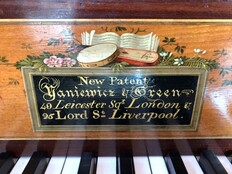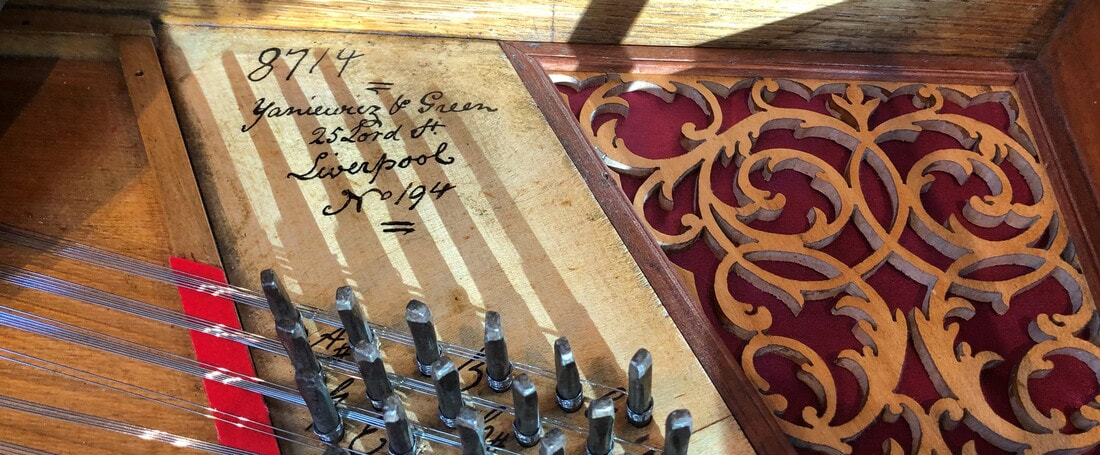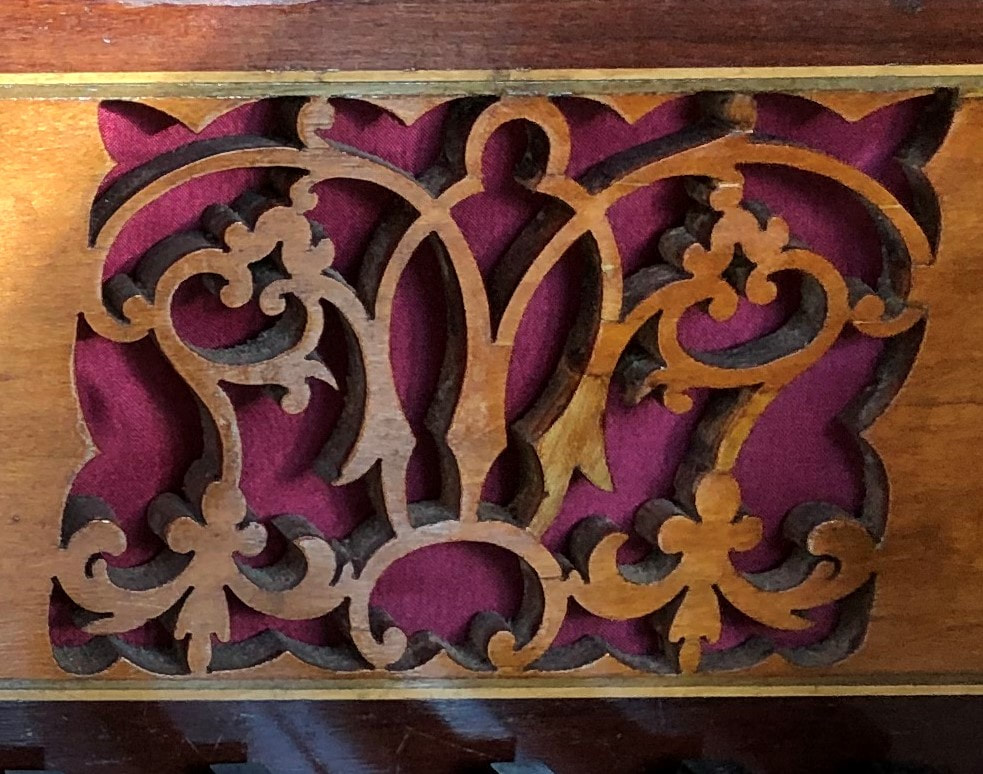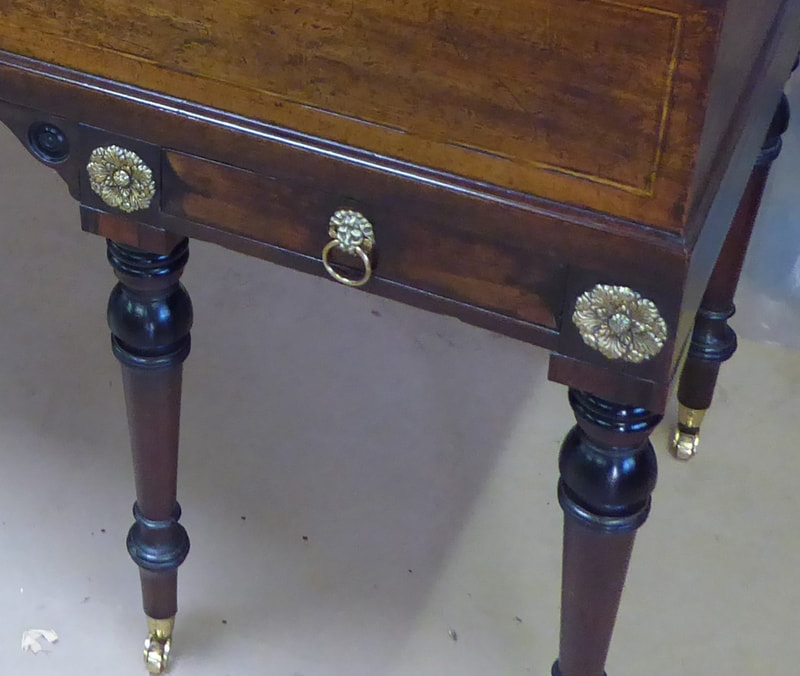The Yaniewicz & Green square piano

Click below to watch a short film about the discovery and restoration of the Yaniewicz & Green square piano, and how it has led to new discoveries about Yaniewicz's life and legacy. The piano was on display in an exhibition at the Georgian House in Edinburgh from June to October 2022, and is now kept at the Polish House on Drummond Place, Edinburgh, where it is used for recitals.
|
|
“Square pianos have become a rarity despite their central place in domestic music-making in the 18th and 19th centuries. This gem of an instrument is wonderful and interesting for two reasons: musically beautiful and in incredible condition following an expert and loving restoration, and also historically fascinating due to the connection with this important composer”
Steven Devine, principal keyboard player, Orchestra of the Age of the Enlightenment |
Two recitals celebrating the piano's arrival in Edinburgh
Following a successful crowdfunding campaign by The Friends of Felix Yaniewicz in partnership with the Scottish Polish Cultural Association, this historic instrument arrived in Edinburgh in November 2021, where it now lives at the Polish House on Drummond Place, just around the corner from where Yaniewicz lived on Great King Street. To mark the occasion, there were two inaugural recitals, hosted by the Polish Consulate, to thank all those whose generous donations enabled us to save this unique piece of Polish-Scottish musical heritage.
On Friday 12th November 2021, Steven Devine gave a recital setting pieces by Yaniewicz in the context of contemporary composers with whom he was associated in different ways over the course of his career: Haydn, Mozart, Clementi, Dussek and Beethoven.
On Sunday 14th November 2021, Pawel Siwczak performed Polish piano music of the 18th and early 19th century by Yaniewicz, Szymanowska, Lessel, Oginski and Chopin, many of whom were writing in exile, in Polonaise and Mazurka dance forms expressing nostalgia for their homeland.
From 25 June to 22 October 2022 the piano was on display as part of an exhibition about Yaniewicz's life and music at The Georgian House in Edinburgh. Read on to learn more about the piano's story.
Following a successful crowdfunding campaign by The Friends of Felix Yaniewicz in partnership with the Scottish Polish Cultural Association, this historic instrument arrived in Edinburgh in November 2021, where it now lives at the Polish House on Drummond Place, just around the corner from where Yaniewicz lived on Great King Street. To mark the occasion, there were two inaugural recitals, hosted by the Polish Consulate, to thank all those whose generous donations enabled us to save this unique piece of Polish-Scottish musical heritage.
On Friday 12th November 2021, Steven Devine gave a recital setting pieces by Yaniewicz in the context of contemporary composers with whom he was associated in different ways over the course of his career: Haydn, Mozart, Clementi, Dussek and Beethoven.
On Sunday 14th November 2021, Pawel Siwczak performed Polish piano music of the 18th and early 19th century by Yaniewicz, Szymanowska, Lessel, Oginski and Chopin, many of whom were writing in exile, in Polonaise and Mazurka dance forms expressing nostalgia for their homeland.
From 25 June to 22 October 2022 the piano was on display as part of an exhibition about Yaniewicz's life and music at The Georgian House in Edinburgh. Read on to learn more about the piano's story.
Two decades ago, a square piano dating from around 1810 came to light in a private house in Snowdonia. Despite its dilapidated condition, it was recognised as an instrument of historical interest by Douglas Hollick, who bought it for restoration and embarked on a research project to discover more about its provenance and the link to Yaniewicz.
Above the keyboard, a cartouche with painted flowers and musical instruments bears the label ‘Yaniewicz and Green’ with the addresses of premises in fashionable areas of London and Liverpool. Inside the piano, a signature in Indian ink has been matched with those on the marriage certificate and surviving letters of Felix Yaniewicz (1762-1848).
Above the keyboard, a cartouche with painted flowers and musical instruments bears the label ‘Yaniewicz and Green’ with the addresses of premises in fashionable areas of London and Liverpool. Inside the piano, a signature in Indian ink has been matched with those on the marriage certificate and surviving letters of Felix Yaniewicz (1762-1848).
Click on the gallery photos to expand
|
|
Douglas Hollick’s research, conducted while restoring the piano, produced the first full account of Yaniewicz’s extraordinary life and career. Published in a scholarly article by the Dolmetsch Foundation in The Consort journal, it formed the basis for a feature more recently published by the British Music Society: Music and Migration in Georgian England: The Story of Felix Yaniewicz and his story recounted here.
Several features of the instrument’s design are similar to other square pianos of the time from the London workshop of Clementi, the foremost manufacturer of the day. Clementi supplied pianos to dealers such as Yaniewicz & Green, who then customised the case for their fashionable clients in London and Liverpool. The ornamentation may have been chosen by the original purchaser (perhaps from pattern books of the time) and has been identified by another early keyboard expert, Derek Adlam, as characteristic of ‘Liverpool bling’!
The features identified by Douglas Hollick as individual to this piano include the unusual pattern of the turned legs, and the brass rosettes (of a design rarely seen on English pianos); along with the lion ring drawer-pulls, these are all original.
Some of the decoration such as the wooden fretwork had been badly damaged; this has been painstakingly renewed as part of the piano’s restoration.
The piano is now returned to its original handsome appearance, and is in exceptionally good working order as an instrument. As Douglas Hollick has observed, ‘The sound is particularly good, since the sound-board is in very fine condition’.
Several features of the instrument’s design are similar to other square pianos of the time from the London workshop of Clementi, the foremost manufacturer of the day. Clementi supplied pianos to dealers such as Yaniewicz & Green, who then customised the case for their fashionable clients in London and Liverpool. The ornamentation may have been chosen by the original purchaser (perhaps from pattern books of the time) and has been identified by another early keyboard expert, Derek Adlam, as characteristic of ‘Liverpool bling’!
The features identified by Douglas Hollick as individual to this piano include the unusual pattern of the turned legs, and the brass rosettes (of a design rarely seen on English pianos); along with the lion ring drawer-pulls, these are all original.
Some of the decoration such as the wooden fretwork had been badly damaged; this has been painstakingly renewed as part of the piano’s restoration.
The piano is now returned to its original handsome appearance, and is in exceptionally good working order as an instrument. As Douglas Hollick has observed, ‘The sound is particularly good, since the sound-board is in very fine condition’.




